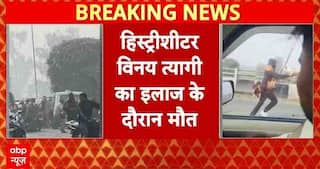Explorer
ABP Exit Poll: BJP emerges as single largest party in Goa

(Photo: PTI/Representational)
New Delhi: In what has been a closely contested assembly election, the ruling Bharatiya Janata Party (BJP) is most likely to emerge as the single largest party in Goa according to the Post Poll (not an Exit Poll) survey conducted in the western coastal State by Lokniti, Centre for the Study of Developing Societies (CSDS) for ABP News. The survey which was conducted in Goa between February 10 and 22 among 1748 respondents spread across 16 randomly selected assembly constituencies found the BJP to be cornering 37 percent of the total vote, four percentage points ahead of its main opponent the Congress which is likely to secure 33 percent votes. With an estimated vote share of 9 percent, Goa’s most prominent regional party, the Maharashtrawadi Gomantak Party (MGP) is likely to finish third in the race, followed closely by the new entrant in Goan politics, the Aam Aadmi Party (AAP), which with an estimated vote share of 7 percent is looking towards staging an impressive debut in the state. The BJP was found to be comfortably ahead of the Congress in Hindu-dominated North Goa. It is expected to poll over two-fifths (41 percent) of the vote in this region, compared to just 31 percent of the Congress. However, the picture changes as we move to Catholic-dominated South Goa, with the Congress being the leading player in the region with an estimated vote share of 36 percent, closely followed the BJP at 33 percent. The entry of AAP seems to have particularly hurt the Congress in South Goa, which has traditionally voted for the Grand old party, but now seems to be toying with the idea of a new politics. About 10 percent of the voters in this region claimed to have voted for AAP in this election. Interestingly, the survey found the anti-incumbency sentiment against the ruling Parsekar government to be fairly strong, with more voters (36 percent) not wanting to see this government back at the helm than those who wish to give it another chance (32 percent). The anti-incumbency factor is particularly strong in South Goa, where almost half the voters (48 percent) said that they did not want to see this government return to power. Despite this the BJP seems to have done well. This may have a lot to do with a divided opposition. Moreover none of the Congress leaders come anywhere close to the popularity of ex-Chief Minister Manohar Parrikar, who was seen campaigning extensively for the party in these elections. This comes out very clearly in the survey. A plurality of respondents (19 percent) expressed a spontaneous preference for Parrikar as Goa’s next Chief Minister, followed by Laxmikant Parsekar who was the chief ministerial choice of 8 percent respondents. The combined popularity of all Congress leaders put together is 21 percent. 
 About the Survey This analysis is based on a Post Poll Survey conducted in Goa by Lokniti, Centre for the Study of Developing Societies (CSDS), Delhi, for ABP News. The survey was conducted from February 10 through February 22, 2017 among 1748 voters in 80 locations (polling stations) spread across 16 assembly constituencies. The sampling design adopted was Multi-stage random sampling. The assembly constituencies where the survey was conducted were randomly selected using the probability proportional to size method. Thereafter, five polling stations within each of the sampled constituencies were selected using the systematic random sampling method. Finally, the respondents were also randomly selected from the electoral rolls of the sampled polling stations. Before going to the field for the survey, field investigators were imparted training about the survey method and interviewing techniques at a day-long training workshop held in Panaji. The field investigators conducted face-to-face interviews of the respondents in Konkani or English asking them a set of standardized questions. The duration of an interview was about 35-40 minutes. At some locations the non-availability of sampled respondents or difficulty in finding households necessitated replacements or substitutions. It must be noted that the post poll survey conducted by CSDS is very different from an exit poll in which voters are approached outside the polling booth on voting day. Instead voters were approached by the field investigators for an interview at their place of residence after votes had been cast in their respective constituencies, but before the results were known. The purpose of the post poll survey was not just to try to understand voting behaviour, but more importantly to understand the reasons why voters chose the parties and candidates they did The achieved sample has been weighted by gender, locality, religion, and caste group, based on Census 2011 information. The poll has an overall margin of error of plus or minus 3.4 points.
About the Survey This analysis is based on a Post Poll Survey conducted in Goa by Lokniti, Centre for the Study of Developing Societies (CSDS), Delhi, for ABP News. The survey was conducted from February 10 through February 22, 2017 among 1748 voters in 80 locations (polling stations) spread across 16 assembly constituencies. The sampling design adopted was Multi-stage random sampling. The assembly constituencies where the survey was conducted were randomly selected using the probability proportional to size method. Thereafter, five polling stations within each of the sampled constituencies were selected using the systematic random sampling method. Finally, the respondents were also randomly selected from the electoral rolls of the sampled polling stations. Before going to the field for the survey, field investigators were imparted training about the survey method and interviewing techniques at a day-long training workshop held in Panaji. The field investigators conducted face-to-face interviews of the respondents in Konkani or English asking them a set of standardized questions. The duration of an interview was about 35-40 minutes. At some locations the non-availability of sampled respondents or difficulty in finding households necessitated replacements or substitutions. It must be noted that the post poll survey conducted by CSDS is very different from an exit poll in which voters are approached outside the polling booth on voting day. Instead voters were approached by the field investigators for an interview at their place of residence after votes had been cast in their respective constituencies, but before the results were known. The purpose of the post poll survey was not just to try to understand voting behaviour, but more importantly to understand the reasons why voters chose the parties and candidates they did The achieved sample has been weighted by gender, locality, religion, and caste group, based on Census 2011 information. The poll has an overall margin of error of plus or minus 3.4 points. 

 About the Survey This analysis is based on a Post Poll Survey conducted in Goa by Lokniti, Centre for the Study of Developing Societies (CSDS), Delhi, for ABP News. The survey was conducted from February 10 through February 22, 2017 among 1748 voters in 80 locations (polling stations) spread across 16 assembly constituencies. The sampling design adopted was Multi-stage random sampling. The assembly constituencies where the survey was conducted were randomly selected using the probability proportional to size method. Thereafter, five polling stations within each of the sampled constituencies were selected using the systematic random sampling method. Finally, the respondents were also randomly selected from the electoral rolls of the sampled polling stations. Before going to the field for the survey, field investigators were imparted training about the survey method and interviewing techniques at a day-long training workshop held in Panaji. The field investigators conducted face-to-face interviews of the respondents in Konkani or English asking them a set of standardized questions. The duration of an interview was about 35-40 minutes. At some locations the non-availability of sampled respondents or difficulty in finding households necessitated replacements or substitutions. It must be noted that the post poll survey conducted by CSDS is very different from an exit poll in which voters are approached outside the polling booth on voting day. Instead voters were approached by the field investigators for an interview at their place of residence after votes had been cast in their respective constituencies, but before the results were known. The purpose of the post poll survey was not just to try to understand voting behaviour, but more importantly to understand the reasons why voters chose the parties and candidates they did The achieved sample has been weighted by gender, locality, religion, and caste group, based on Census 2011 information. The poll has an overall margin of error of plus or minus 3.4 points.
About the Survey This analysis is based on a Post Poll Survey conducted in Goa by Lokniti, Centre for the Study of Developing Societies (CSDS), Delhi, for ABP News. The survey was conducted from February 10 through February 22, 2017 among 1748 voters in 80 locations (polling stations) spread across 16 assembly constituencies. The sampling design adopted was Multi-stage random sampling. The assembly constituencies where the survey was conducted were randomly selected using the probability proportional to size method. Thereafter, five polling stations within each of the sampled constituencies were selected using the systematic random sampling method. Finally, the respondents were also randomly selected from the electoral rolls of the sampled polling stations. Before going to the field for the survey, field investigators were imparted training about the survey method and interviewing techniques at a day-long training workshop held in Panaji. The field investigators conducted face-to-face interviews of the respondents in Konkani or English asking them a set of standardized questions. The duration of an interview was about 35-40 minutes. At some locations the non-availability of sampled respondents or difficulty in finding households necessitated replacements or substitutions. It must be noted that the post poll survey conducted by CSDS is very different from an exit poll in which voters are approached outside the polling booth on voting day. Instead voters were approached by the field investigators for an interview at their place of residence after votes had been cast in their respective constituencies, but before the results were known. The purpose of the post poll survey was not just to try to understand voting behaviour, but more importantly to understand the reasons why voters chose the parties and candidates they did The achieved sample has been weighted by gender, locality, religion, and caste group, based on Census 2011 information. The poll has an overall margin of error of plus or minus 3.4 points. 
Follow Breaking News on ABP Live for more latest stories and trending topics. Watch breaking news and top headlines online on ABP News LIVE TV
Read more






































